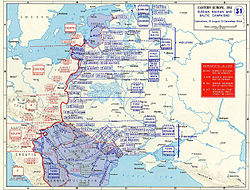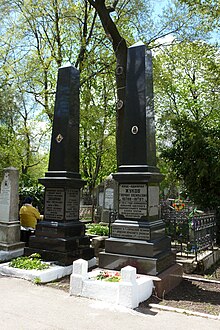Odessa Military District
You can help expand this article with text translated from the corresponding article in Ukrainian. (February 2024) Click [show] for important translation instructions.
|
| Odessa Military District | |
|---|---|
Invasion of Poland (selected units), Invasion of Romania, World War II | |
| Commanders | |
| Notable commanders | Georgy Zhukov (06/1946 - 02/1948) |
The Odessa Military District (
The district was originally established by the
An earlier district of the same name was established in 1864 by the Imperial Russian Army.
History

Years of existence
- December 24, 1862 – January 1918 Russian Empire, transformed into headquarters of Romanian Front
- April 9 – August 5, 1919 Russian SFSR, dissolved, remnants transferred to 12th Army
- October 11, 1939 – September 10, 1941 Soviet Union, dissolved remnants transferred to Southern Front
- March 23, 1944 – January 3, 1992 Soviet Union, passed on to Armed Forces of Ukraine
- July 9, 1945 – April 4, 1956, portion of territory was under jurisdiction of Tauric Military District
- July 9, 1945 – April 4, 1956, portion of territory was under jurisdiction of
- January 3, 1992 – January 3, 1998 Southern Operational Command
Russian Empire

The Odessa Military District was established during the reforms of the Russian military minister
Soviet Union
The district was reformed by the decision of October 11, 1939 specifically for the occupation of Bessarabia after the Soviet Union signed
By directives OV/583 and OV/584 of the Soviet
Two action plans were devised. The first plan was prepared for the case that Romania would not accept to evacuate
On June 22, 1941 primary combat formations included:[2]
- 9th Army was relocated to the District as 9th Separate Army in June 1941 from the Leningrad Military District after the Winter War and invasion of Romania
- 2nd Mechanised Corps and 18th Mechanised Corps were associated with 9th Army.
- 7th Rifle Corps was formed in the District in June 1941,
- 9th Rifle Corps formed as part of the District on June 22, 1941,
- 3rd Airborne Corps
In August 1941 51st Independent Army was formed in the Crimea.
On September 10, 1941 the district was abolished as it was overran by the Armed Forces of Nazi Germany and its allies.

Post World War II Development
The District was reformed on April 23, 1944 with its headquarters at
In May 1955 the district's forces included the
In 1960 the 113th Guards Motor Rifle Division and 95th Motor Rifle Division were disbanded.
In April 1960 the Odessa Military District consisted of three oblasts (
From September 1984 the District came under command of the South-Western Strategic Direction, with its headquarters at
Later developments
In the Odessa District's territory were additionally deployed the
The
The Odessa Military District was transferred to the jurisdiction of Ukraine after the
Its units were split between the

Commanders
Commanders 1862-1914
- Paul Demetrius von Kotzebue Count, General of Infantry (12.12.1862 — 11.01.1874)
- Vladimir Savvich Semeka, Adjutant General, Lieutenant General (11.01.1874 — 01.04.1879)
- Eduard Totleben, Count, Adjutant General, Engineer General, Interim Governor General (01.04.1879 — 18.05.1880)
- Alexander Drenteln Adjutant General, General of Infantry, Interim Governor General (18.05.1880 — 14.01.1881)
- Alexander Mikhailovich Dondukov-Korsakov Prince, General of the Cavalry, Adjutant General, Interim Governor General (14.01.1881 — 01.01.1882)
- Iosif Gurko Adjutant-General, General of the Cavalry, Interim Governor-General (09.01.1882 — 07.07.1883)
- Christopher Roop General of Infantry, Provisional Governor General (21.10.1883 — 12.10.1890)
- Alexander Ivanovich Musin-Pushkin, Count, General of the Cavalry (23.10.1890 — 19.12.1903)
- Alexander von Kaulbars Baron, Lieutenant General (01.01.1904 — 22.10.1904)
- Semyon Vasilievich Kakhanov, General of the cavalry (10.1904 - 27.08.1905)
- Alexander von Kaulbars, Baron, General of the Cavalry (27.08.1905 — 23.12.1909)
- Nikolai Zarubaev, General of Infantry (24.12.1909 — 10.06.1912)
- Vladimir Nikolaevich Nikitin, General of artillery (13.06.1912 — 19.07.1914)
Commanders, 1939–1991
- Lieutenant General Ivan Boldin (10.1939 — 07.1940)
- Lieutenant General Yakov Cherevichenko (07.1940 — 06.1941)
- Lieutenant General Nikandr Chibisov (06.1941 — 08.1941)
- Major General Ivan Ivanov (08.1941 - 09.1941)
- German occupation
- General Colonel Ivan Zakharkin (03.1944 — 10.1944)
- Major General Aleksei Pervushin (10.1944)
- General Colonel Vasily Yushkevich (10.1944 - 06.1946) (former commander of 31st Army)[11]
- Marshal of the Soviet Union Georgy Zhukov (06.1946 – 02.1948)
- General Colonel Nikolay Pukhov(02.1948–1951),
- General Colonel Kuzma Galitsky (1951–1954),
- General Colonel Alexei Radzievsky (1954–1959),
- General Colonel Hamazasp Babadzhanian (P H Babadjanyan) (1959-03.1967),
- General Colonel M V Lugovtsev (03.1967 – 12.1967)
- General Colonel A G Shyrypov (01.1968 – 1974)
- General Colonel I M Voloshin (1974–1982)
- General Colonel S A Elagin (1982–1986)
- General Colonel Ivan S Morozov (1986–1992)
Forces in the 1980s
Around 1988, the District contained the following forces:[12]
- 14th Guards Army
- 28th Guards Motor Rifle Division (28th Guards Mechanised Brigadecirca 2001)
- 59th Guards Motor Rifle Division (Tiraspol)
- Belgorod-Dnestrovsky)
- 28th Guards Motor Rifle Division (
- 32nd Army Corps 'Кенигсберский' (Simferopol)[13]
- 126th Motor Rifle Division (Simferopol) Formed 17 November 1964.[14] Transferred to the Black Sea Fleetin 1989. Disbanded 1 February 1996.
- Feodosiya)(501st Motor Rifle Regiment (Kerch), 84th Motor Rifle Regiment, 91 мсп, ап (Керчь), зрп). In 1990 became the 5378th Base for Storage of Weapons and Equipment. Came under Ukrainian control 1992.
- 1398th Anti-tank Artillery Regiment (Lugovoe/Луговое)
- Other corps troops included the - 9th Engineer-Sapper Battalion, 909th Signals Battalion, 287 радиотехнический батальон, 858 ремонтно-восстановительный батальон (Мазанка) - 301st Artillery Brigade (Simferopol)
- District Troops
- 92nd Guards Training Motor Rifle Division (Nikolaev/Shirokiy Lan) - Reorganised as the 150th District Training Centre, and later after Ukrainian independence, the 92nd District Training Centre.[15]
- Bolgrad)
- 40th independent Landing-Assault Brigade (Nikolayev, Odesa Oblast, from October 1979).79th Airmobile Brigade.
- 10th independent Special Forces Brigade GRU (activated 10.62 in Karagoz, Crimean Oblast). Taken over by Ukraine early 1992 (directive issued 11.10.91).
- Zaporozhia/Novaya Alexandrovka)[17]In 1988 consisted of 371st Multiple rocket Launcher Brigade (48 9A52 "Smerch") and two artillery regiments - 701st Howitzer artillery regiment (48 units of D-30) and 751st antitank artillery regiment (84 MT-LBT guided missile system), and 3 shelves and 2 base in Novo-Aleksandrovka
- 5th Air Army
Ukraine/Moldova
Following the
The 5381st Equipment Storage Base with its headquarters at Florești, the former 86th Guards Motor Rifle Division, was taken over by Moldova.[18]
The 5th Air Army was later redesignated the 5th Aviation Corps of the Ukrainian Air Force in 1994.[19]
Colonel General
Commanders (Ukraine)
- General Lieutenant Vitaliy Radetsky (1992–1993)
- Colonel General Volodymyr Shkidchenko (1993–1998)
Notes
- ^ a b Feskov et al. 2013, p. 495.
- ^ Orbat.com/Niehorster, Administrative Order of Battle 22 June 1941, accessed August 2009
- ^ Feskov et al. 2013, p. 49.
- ^ Tsouras 1994, pp. 43–44.
- ^ Feskov et al. 2013, p. 491.
- ^ Feskov et al 2004, 49.
- ^ "93rd Motorised Rifle Division".
- ^ Holm, High Command of the South-Western Direction, 2015
- ^ Feskov et al 2004, p.47
- ^ William E. Odom, The Collapse of the Soviet Military, Yale University Press, 1998, p.383 citing 'Colonel General Ivan Bizhan, Deputy Minister of Defence in Ukraine, related this episode to me and others on 12 October 1996.'
- ^ Курская Битва
- ^ Feskov et al 2004., for most formations.
- ^ Feskov et al 2004, 57.
- ^ "126th Motorised Rifle Division".
- ^ Feskov et al.
- ^ Michael Holm, 40th independent Landing-Assault Brigade
- ^ Jane's Intelligence Review March 1992 for HQ location.
- ^ "86th Guards Motorised Rifle Division".
- ^ Lisitsa, Nikifor (2002). Шестидесятилетний юбилей отметил 5-й авиационный корпус [Diamond Jubilee of the 5th Aviation Corps]. Narodnaya Armiya (in Russian). Archived from the original on 10 May 2015. Retrieved 29 May 2017.
- Feskov, V. I.; Golikov, V. I.; Kalashnikov, K. A.; Slugin, S. A. (2013). Вооруженные силы СССР после Второй Мировой войны: от Красной Армии к Советской [The Armed Forces of the USSR after World War II: From the Red Army to the Soviet: Part 1 Land Forces] (in Russian). Tomsk: Scientific and Technical Literature Publishing. ISBN 9785895035306.
- ISBN 0-8160-3122-3.
Further reading
- Lenskii, A. G. (2000). Sukhoputnye sily RKKA v predvoennye gody Сухопутные силы РККА в предвоенные годы [Land forces of the Red Army in the pre-war years]. St. Petersburg: B&K.
- Military Encyclopedic Dictionary. Moscow. 2002.
{{cite book}}: CS1 maint: location missing publisher (link)
External links
- (in Russian) Ultimatum of the Soviet government to Romanian government on June 26, 1940
- (in Russian) Odesa Soviet Military District
- (in Russian) Odesa Russian Military District
- (in Russian and Ukrainian) Южному ОК - 70 лет. 2009 год. Фильм.
